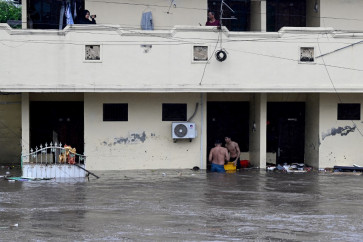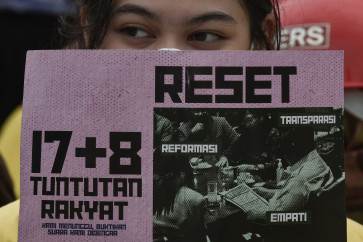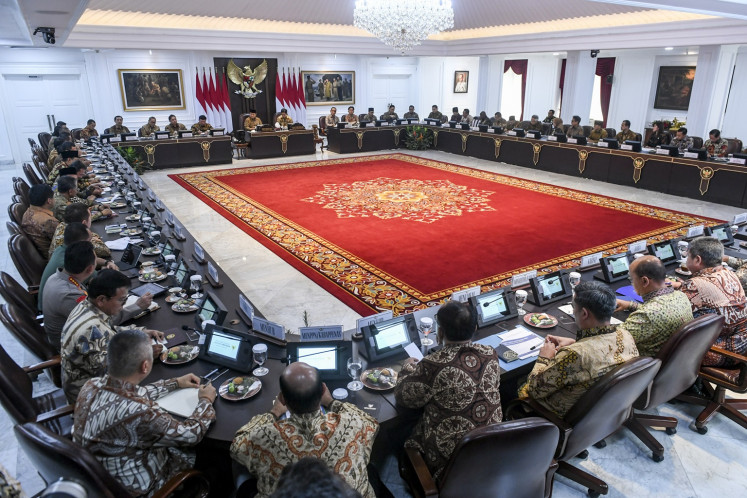Popular Reads
Top Results
Can't find what you're looking for?
View all search resultsPopular Reads
Top Results
Can't find what you're looking for?
View all search resultsLearning to practice batik making at Textile Museum
Amid the hustle and bustle of traffic and commerce in Central Jakarta's Tanah Abang area stands an European-styled building
Change text size
Gift Premium Articles
to Anyone
Amid the hustle and bustle of traffic and commerce in Central Jakarta's Tanah Abang area stands an European-styled building.
The former residence of a French citizen now houses the Textile Museum, with its large front yard and its shady trees in stark contrast to the hectic life on the street.
The spacious and quiet room of the museum displays a wide variety of cloths from different parts of Indonesia, each labeled with information on their origins, types of material, production processes and purposes of use. A visitor will get to know, for example, that South Sumatra's capital city of Palembang also has its own batiks, while men in the interior regions of Kalimantan wear clothes made of refined bark as smooth as textiles.
When The Jakarta Post recently visited the museum, a batik making course was announced near the back of the museum.
After passing a large garden, visitors reached a fairly big hall. It's actually a garden of various plants used as natural coloring dyes. Young teak leaves, for instance, can be used to paint cloth maroon.
A girl creates batik at the Textile Museum in West Jakarta. (JP/Juliana Harsianti)
Some people were seen taking a batik course in the hall, drawing patterns on fabrics and waxing the motifs already drafted.
For beginners, the cost is Rp35,000 per person, including the cloth for patterning, wax and colorings. Participants run the gamut from housewives and teenagers to working professionals and retirees.
Those who are not so good at drawing need not worry, as different samples of motifs are available for copying onto fabrics before being hot-waxed by using a canting, or spouted copper vessel.
All the participants seriously applied wax on their drawings, with occasional whines as the hot wax dropped on their hands or went on the wrong lines.
According to Yeni, the course's part-time batik teacher and an Indonesian Arts Institute graduate, many people did not understand the waxing process is to prevent colors from mixing together.
"If a batik cloth is composed of various colors, dyeing and waxing of colored parts are usually done several times," she said.
After the dyeing process is completed, the wax is removed by boiling the cloth and then the hand-made batik is sun-dried.
Many of the participants had long known about the course before signing up.
"I could attend the course only this time," said Jeanette, who with her friend Paulina visited the museum from Pluit, North Jakarta, especially to learn batik making. "I really want to be able make a batik piece by hand."
Yeni said apart from adults, a lot of students interested in batik would come in study-tour groups organized by their schools.
"Though students sometimes get burned by the wax, they're happy to be able to make batik handkerchiefs to be taken home. They usually get simple motifs and only need to dye the pieces only once."
The course is also good to help children learn to concentrate. "This is particularly for autistic children," said Yeni, who has several times conducted art therapy for children with autism.
She said that although there are standard batik making norms, participants are free to draw whatever they like on their works.
"Some have even drawn bells and snowmen amid Solo's traditional batik motifs."
An advanced course is also available, costing Rp200,000 to make big-sized fabrics for scarves, tablecloths or sarongs. The motifs for this level are more complicated and require a longer time to complete.
"Many employees come here on Saturdays and Sundays to finish their batik as the process is longer, which is not the case for beginners," added Yeni.
Textile Museum
Jl. KS Tubun No. 4, West Jakarta
Phone: 021-5606613
Batik courses are available Sunday and Tuesday-Friday from 9:30 a.m. to 3 p.m. and on Saturdays from 9:30 a.m. to 1 p.m.










